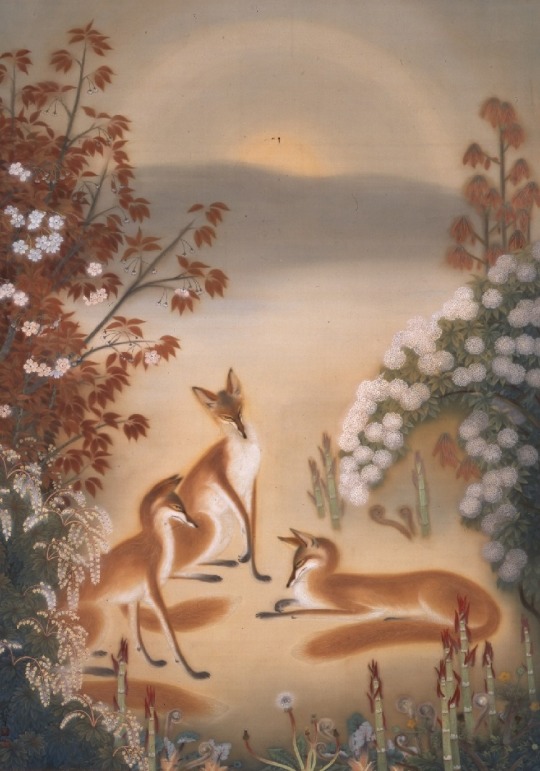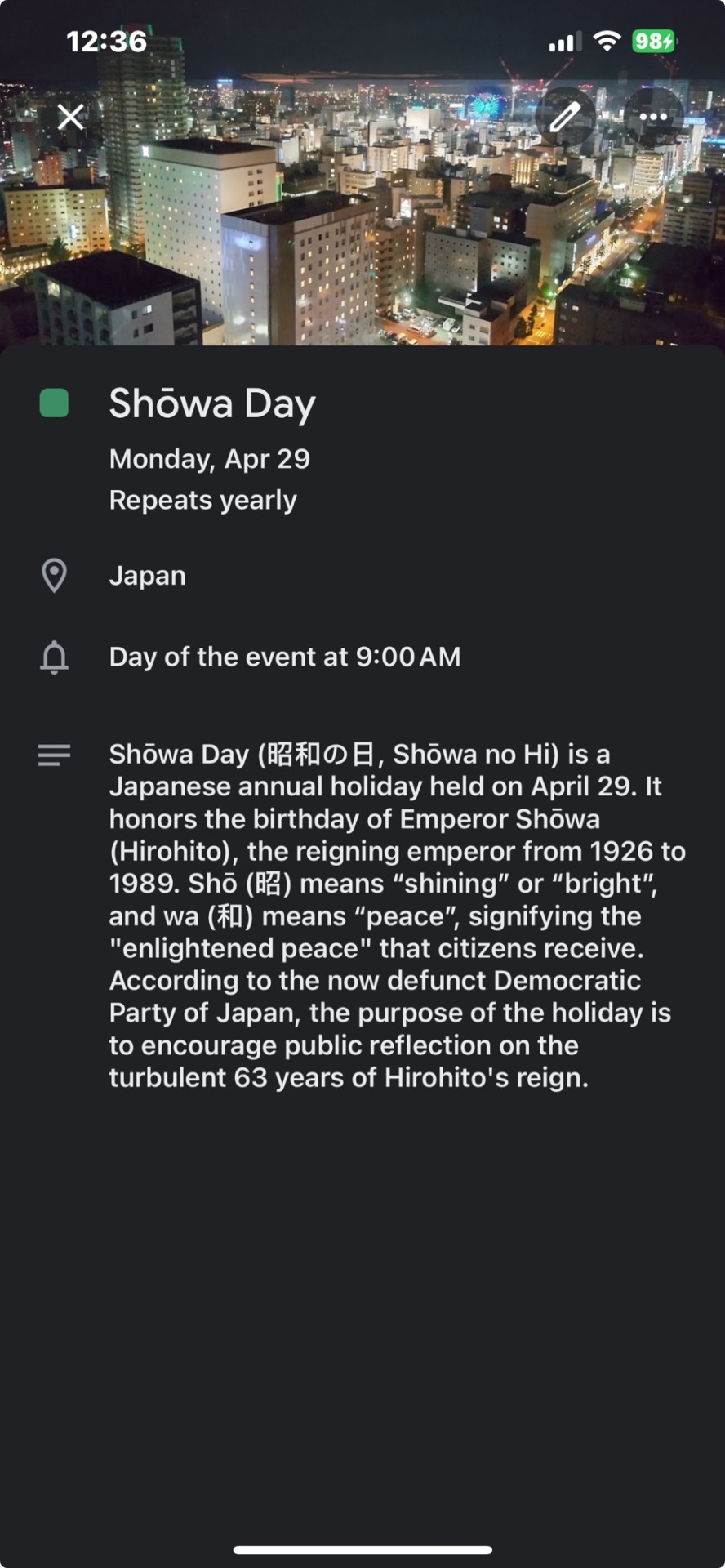#Shōwa
Explore tagged Tumblr posts
Text





• Formal summer kimono for a woman with fuyō and nadeshiko.
Period: Shōwa period
Place of origin: Japan
Medium: Gauze weave; stencil-printed on the fabric surface, silk.
#fashion history#history of fashion#fashion#vintage clothing#vintage fashion#vintage#kimono#japanese#japan#summer#Shōwa#green
976 notes
·
View notes
Text

Crown Prince Hirohito, later Emperor Shōwa of Japan
Japanese vintage postcard
#postal#emperor#crown prince hirohito#hirohito#historic#ansichtskarte#later#shōwa#sepia#vintage#tarjeta#shwa#briefkaart#photo#japanese#crown#postkaart#ephemera#postcard#postkarte#japan#photography#prince#carte postale
3 notes
·
View notes
Photo

Katayama Bokuyō
Oboro. 1927
#katayama bokuyō#art on silk#nihonga style#animal paintings#beautiful nature#blurred style#shōwa era#japanese artist#hiroshima prefectural museum of art
667 notes
·
View notes
Text
Miyako Odori - Rice Planters' Dance 1928

Rice planters' dancing in a sacred field. Miyako Odori (Cherry Dance) for November 1928.
Hōju banzai raku (music in celebration of long life), a special performance of the Miyako Odori (Cherry Dance) to celebrate the coronation of Emperor Shōwa in November 1928.
16 notes
·
View notes
Text
Obscure Anime of The Day:

Shouwa Genroku Rakugo Shinjuu
Aired: 2016
Genres: Comedy, Drama, Historical, Josei, Musik, Romance, Slice of Life
#Showa and Genroku Era Lover's Suicide Through Rakugo#Shouwa Genroku Rakugo Shinjuu#昭和元禄落語心中#Shouwa Genroku Rakugo Shinjuu (2016)#Showa Genroku Rakugo Shinju#Obscure Anime of The Day#anime#josei anime#anime nostalgia#historical anime#rakugo#obscure anime#Shōwa Genroku Rakugo Shinjū
30 notes
·
View notes
Note
What are your thoughts on rpf? Twitter has been very loud with this for the past week and im surprised they haven't moved on from it
It's not my cup of tea, but I don't care what other people are doing with their time on earth re: fan fiction. I'm fond of erotic, grotesque nonsense myself, so far be it from me to cast stones in my glass house.
#i mean it in the shōwa era meaning of the phrase#but i also mean it in the literal meaning of the phrase#so#take from that what you will
2 notes
·
View notes
Text

There are four lost paintings by Jasper Johns, and this is the smallest, and second most interesting. [The first, of course, is the flag painting in Robert Rauschenberg's Short Circuit, which was Johns' first flag painting, and which was stolen in 1966. I spent more than two years tracking it. But that's not important now.]
Titled Gastro, this little encaustic collage has a coaster from the Tokyo bar Gastro, which Johns frequented during his visit to Japan in 1964. Johns gave it to the owner, Miyagaki Shōichirō [宮垣 昭一郎], and it hung on the wall of Gastro until Shōichirō's death in 1988.
image: Jasper Johns, Gastro, 1964, encaustic and collage on canvas, 5 x 5 in., reproduced as P145 in Johns' catalogue raisonné
3 notes
·
View notes
Text
Here it is, one of my all time favorite Shōwa manga that I sadly couldn’t find anywhere online, and very little information about in general. I bought the books back in 2021 and finally got around to scanning, formatting, and uploading them online so everyone can enjoy. So, here’s volume 1 of Hiroshi Kaizuka’s WW2 boys’ manga Zerosen Red! Volume 2 will also be up soon 😋
Really hoping by making the whole thing available I can get more people into it so they can hear my endless autistic rambles about this 60 year old comic :,D
A friend and I are also in the process of translating both books into English… a beast of a project but one that I’m thoroughly enjoying 👀 I’m so damn excited by the prospect of other people discovering this and becoming as obsessed as I am >:3
#ゼロ戦レッド#retro manga#vintage manga#1960s#60s manga#archive#Hiroshi Kaizuka#shouwa manga#shōwa manga#showa manga#pacific theatre#pacific theater#WW2#historical fiction#Sunday comics#Zerosen Red
5 notes
·
View notes
Text
I’m finally properly watching Ultraseven and blow me down it’s already my favorite? I love Ultra Q and ‘66 Ultraman, but this is on another fucking level?
#outside of Q and the original 1966 Ultraman I’ve only seen bits and select episodes of the Shōwa#holy shit this thing is lavish?
2 notes
·
View notes
Text

#google calendar#calendar#Japan#shōwa day#japanese holiday#holiday#annual holiday#japanese annual holiday#Japanese
0 notes
Text

Okay, so I just finished Juspion, and overall it was pretty good. Not perfect mind you, for a lot of the show the story kinda felt like it was either going in circles or nowhere at all, but the characters where enjoyable, the action was fun, and any hero show with a Giant Mecha is worth a watch in my book. This was my first ever Metal Heroes show, as well as my first reel foray in stuff from the Shōwa era, and now I’m excited to check out more from both categories!
Juspion gets a 7/10, easy recommendation.
0 notes
Text
Iyo looks cute in these photos.


41 notes
·
View notes
Photo

Ohara Koson: Kingfisher on Snowy Stump, Shōwa period, 1935
2K notes
·
View notes
Text
the thing about godzilla films is that western godzilla films are almost universally just “there seems to be….. a big scary monster!! we need to fight it…… but it’s too powerful!!” so it’s always a surprise when you watch a japanese and especially a shōwa era film and it’s got the most batshit labyrinthine plot going on. like are we just not going to address that political assassination that happened like twenty minutes ago. also why are the twins on a game show
153 notes
·
View notes
Text

A number name today! The surname 三戸 is read Mito here, but it can also be Sannohe or Sando. It belongs to about 7000 people.
三 means three. It's read み, み.つ, みっ.つ, サン, or ゾウ.
戸 means door. It's also the counter for houses. It's read と or コ.
Also, as a bonus, some geographical facts! 三戸 Sannohe is also a place, one of eight sequentially-named towns and cities up north in Iwate and Aomori! Here they all are on a map!

It goes from 一戸 Ichinohe to 九戸 Kunohe, but if you count the markers, you'll notice there are only eight, not nine. Why? I'd assumed it was 四・死 superstition but apparently there's a historical reason instead!
Centuries ago, there *was* a town called 四戸 Shinohe, but in 1591, it took up arms in a rebellion against Toyotomi Hideyoshi. They were defeated (they had 5,000 soldiers; he sent 60,000), and the territory was then divided up and reallocated to Sannnohe and Hachinohe. Shinohe was no more.
Fast forward to the Great Heisei Mergers ('90s and 00s), and Shinohe did almost make a comeback. Japan's population distribution was in flux, and rural areas particularly were struggling with depopulation and access to facilities and services (still a big problem today—a really big problem, actually). The government started to reorganize smaller communities, having them merge or absorb each other. (They also did this during the Meiji and Shōwa periods.)
In Aomori, the number of municipalities went from 67 to 40, and one of the newly formed towns—an amalgamation of 南部町 Nanbu-chō, 名川町 Nagawa-machi, and 福地村 Fukuchi-mura—did consider adopting the name Shinohe. Ultimately, though, it lost in a vote to 南部町 Nanbu-chō, which is understandable, tbh. Better stick with something people already know than give your struggling community a new name whose pronunciation is indistinguishable from "Death's Door." Actually, maybe the reason Shinohe doesn't exist today has a little to do with superstition after all.
73 notes
·
View notes
Text




Happy #MiniatureMonday!
Happy #TinyTuesday!
昭和の豆テレビ [Shōwa no mame terebi], or Showa Era TV, is a 2013 miniature TV set created by the Japanese artist Fūdō. Nested inside the miniature TV are three miniature books.
Japan’s Shōwa era was a political period corresponding with the reign of Emperor Shōwa. After World War II, Shōwa era television was heavily defined by the inclusion of kaiju, or monsters, and tokusatsu, or practical special effects. Popular franchises from this era include Godzilla and Ultraman.
Fūdō explains in an insert accompanying the TV set that the post-war Showa era 30s and 40s (the mid-1950s to 1970s) “evoke a sense of nostalgia for many Japanese people, since it was the period of economic growth which dramatically changed their lifestyles.” The miniature books in this set depict symbolic objects from the daily lives of children of the Showa 30s and 40s.
Smith Miniatures Collection , N7433.4.F825 S46 2013
M Clark, Instruction Graduate Assistant
#miniaturemonday#uiowa#libraries#special collections#library#japanese#showa era#godzilla#tiny#television
69 notes
·
View notes